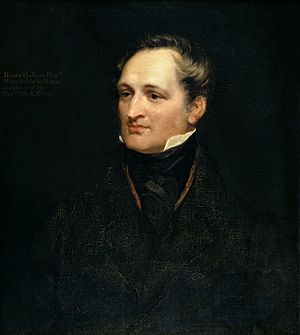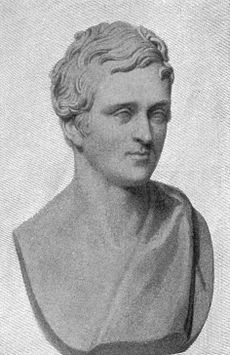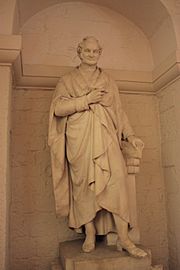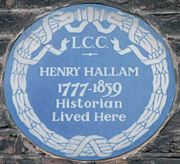Henry Hallam facts for kids

Henry Hallam FRS FRSE FSA FRAS (born July 9, 1777 – died January 21, 1859) was an English historian. He studied at Eton College and Christ Church, Oxford. For some years, he worked as a lawyer. Later, he decided to focus on writing history.
His most important books include View of the State of Europe during the Middle Ages (1818). He also wrote The Constitutional History of England (1827). Another major work was Introduction to the Literature of Europe (1837). Hallam did not take part in politics himself. However, he knew many writers and politicians from the Whig party. Some people, like Robert Southey, thought his history books favored the Whigs.
Hallam was a member of the Royal Society. He was also a trustee of the British Museum. In 1830, he received a gold medal for his historical writings. This medal was created by King George IV.
Contents
Henry Hallam's Life Story
Early Life and Education
Henry Hallam was born on July 9, 1777. He was the only son of Reverend John Hallam. His father was a church leader in Windsor and Bristol. Henry went to Eton College and then Christ Church, Oxford. He finished his studies in 1799.
After college, he became a lawyer. He worked in the legal field for several years. However, he loved books and writing more than law.
Becoming a Historian
In 1812, his father passed away. Henry inherited a small estate. This allowed him to stop practicing law. He then dedicated his time to studying and writing.
Hallam was connected to important writers and politicians. These were the leaders of the Whig party. This connection helped him get a good job as a commissioner of stamps. This job paid well and was not too demanding. Even with this job, he did not get involved in politics directly. However, he supported many popular causes. He was especially active in the movement to end the slave trade. He believed in the political ideas of the Whigs.
His Major Works
Hallam's first writings were for the Edinburgh Review. This was a Whig newspaper. His review of Walter Scott's book about Dryden gained attention.
His first big history book was View of the State of Europe during the Middle Ages. It came out in two volumes in 1818. Nine years later, he published The Constitutional History of England (1827). This also had two volumes.
His four-volume work, Introduction to the Literature of Europe, appeared in 1837. He also published extra notes for his Middle Ages book in 1843. In 1852, he released Literary Essays and Characters. These books represent most of Hallam's work as a writer.
Hallam's Historical Books
Understanding the Middle Ages
Hallam described his book Middle Ages as a series of essays. These essays covered history from the 5th to the 15th century. The book has nine long chapters. Five chapters cover the histories of France, Italy, Spain, Germany, and the Greek and Saracen empires.
Other chapters look at important parts of medieval society. These include the feudal system, the church system, and England's political system. The last chapter describes society, trade, manners, and literature during the Middle Ages.
England's Constitutional History
His book The Constitutional History of England (1827) continued from his Middle Ages work. It started with the rule of Henry VII. It went up to the rule of George III. Hallam stopped here because he did not want to write about current political issues.
However, he was still accused of being biased. A newspaper called the Quarterly Review criticized his book in 1828. Robert Southey wrote that the book showed Hallam was "a decided partisan." Southey was upset by how Hallam wrote about King Charles I, Thomas Cranmer, and William Laud.
Hallam, like Thomas Babington Macaulay, believed in the ideas of Whig history. This means he looked at history through the lens of Whig political beliefs. But he was careful with his facts. This made Constitutional History a very important book for studying English politics.
Hallam's Literary History Works
Hallam's four-volume book, Introduction to the Literature of Europe (1837–1839), continued a topic from his View of the Middle Ages. The first chapter describes the state of literature in Europe up to the end of the 14th century. It talks about how ancient learning was lost after the fall of the Roman empire. It also mentions how the Christian church helped keep the Latin language alive. And it covers the rebirth of learning after the 7th century.
For the first 150 years of his study, he mainly reviewed classical learning. He looked at short ten-year periods. He noted the important books from each time. For the period 1520–1550, he had separate chapters. These covered ancient literature, theology, science, philosophy, and law. He also looked at literature of taste and other writings.
He divided subjects even more in later periods. For example, poetry, drama, and polite literature got their own chapters. An author might be mentioned in many chapters. William Shakespeare, Hugo Grotius, Francis Bacon, and Thomas Hobbes appear in several different places.
The book did not include biographies of authors. Instead, it was an account of the books themselves. It was like a complete library of the period. The books were organized by when they were published and what they were about.
Death and Memorials
Henry Hallam passed away in London on January 21, 1859. He was 81 years old.
There is a memorial for him in the crypt of St Paul's Cathedral in London. Also, a blue plaque is on the building at 67 Wimpole Street in London. The London County Council put it there to show that he once lived in that house.
Hallam's Family Life

In 1807, Henry Hallam married Julia Maria Elton. She was the daughter of Sir Charles Abraham Elton. Julia passed away in 1847.
Hallam experienced great sadness in his life. He lost all his children one after another. His oldest son was the poet Arthur Henry Hallam. He is known as "A.H.H." in Tennyson's famous poem, In Memoriam A.H.H.. Arthur died in 1833 when he was only 22 years old. In 1834, Hallam edited and published a collection of Arthur's writings. In 1850, his second son, Henry Fitzmaurice Hallam, also passed away.



